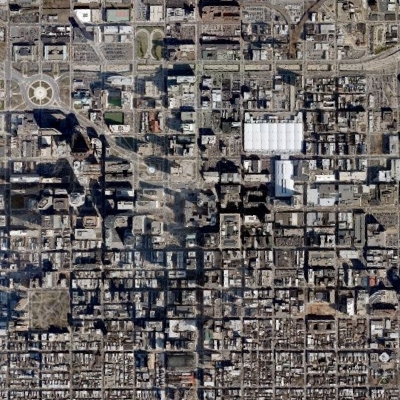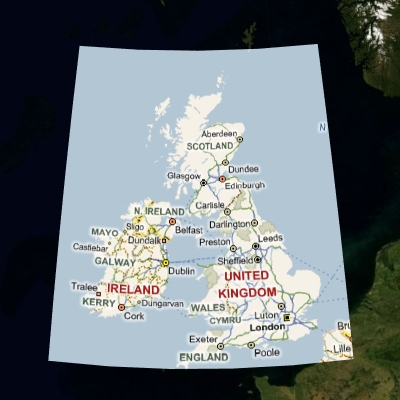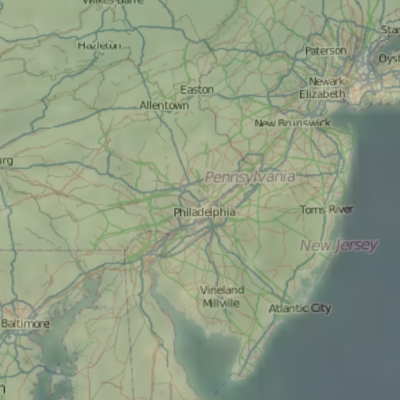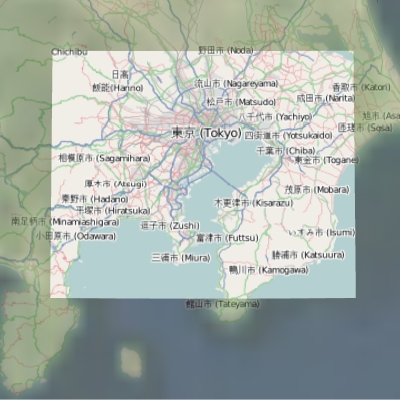Web Imagery Overlays |
Insight3D® provides several web imagery overlays which can be used to load imagery from network or internet servers.
Each overlay can be constructed with a server name and a CartographicExtent. The extent defines the bounds of the imagery drawn on the globe and can be smaller than the bounds of the actual imagery. The default constructor uses a default server and the entire extent of the image. As with other overlays, these overlays can be added or removed from the globe, made translucent, and interleaved with each other. Multiple overlays of the same class can be placed on the globe at the same time.
Bing Maps for Enterprise (previously Microsoft Virtual Earth) is a mapping platform created by Microsoft, accessed using the BingMapsForEnterpriseImageGlobeOverlay class. The BingMapsStyle enumeration determines which type of imagery is used. The following example adds aerial imagery to the entire globe and road data around the United Kingdom:
BingMapsForEnterpriseImageGlobeOverlay aerialEntireEarth = new BingMapsForEnterpriseImageGlobeOverlay(BingMapsStyle.Aerial); CartographicExtent extent = new CartographicExtent(Trig.DegreesToRadians(-12.0), Trig.DegreesToRadians(50.0), Trig.DegreesToRadians(3.0), Trig.DegreesToRadians(60.0)); BingMapsForEnterpriseImageGlobeOverlay roadUK = new BingMapsForEnterpriseImageGlobeOverlay(BingMapsStyle.Road, extent); scene.CentralBodies.Earth.Imagery.Add(aerialEntireEarth); scene.CentralBodies.Earth.Imagery.Add(roadUK);
The following images show Bing Maps For Enterprise imagery loaded onto the globe.


The default constructor uses Microsoft's Bing Maps for Enterprise Production server to cover the entire globe, using the BingMapsStyle.AerialWithLabels map style. Other constructors for this overlay allow configuration of the following parameters: server, application key, proxy, BingMapsStyle, and CartographicExtent.
OpenStreetMap (OSM) is a free, open, and editable map of the world. Its content is updated in a way similar to that of Wikipedia, and is accessed using the OpenStreetMapImageGlobeOverlay class.
OpenStreetMapImageGlobeOverlay entireEarth = new OpenStreetMapImageGlobeOverlay(); CartographicExtent extent = new CartographicExtent(Trig.DegreesToRadians(139.0), Trig.DegreesToRadians(35.0), Trig.DegreesToRadians(140.5), Trig.DegreesToRadians(36.0)); OpenStreetMapImageGlobeOverlay tokyo = new OpenStreetMapImageGlobeOverlay("http://tile.openstreetmap.org", extent); entireEarth.Translucency = 0.5f; scene.CentralBodies.Earth.Imagery.Add(entireEarth); scene.CentralBodies.Earth.Imagery.Add(tokyo);
The following images show OpenStreetMap imagery loaded onto the globe.


The default constructor uses the OpenStreetMap tile server hosted at http://tile.openstreetmap.org to cover the entire globe. Other constructors for this overlay allow configuration of the following parameters: server and CartographicExtent. If you decide to host a personal OpenStreetMap tile server, the format of the URL has to be kept the same as the official one. More detail about this can be found on http://wiki.openstreetmap.org/wiki/Main_Page.